Benjamin Roth
Principled Personas: Defining and Measuring the Intended Effects of Persona Prompting on Task Performance
Aug 27, 2025Abstract:Expert persona prompting -- assigning roles such as expert in math to language models -- is widely used for task improvement. However, prior work shows mixed results on its effectiveness, and does not consider when and why personas should improve performance. We analyze the literature on persona prompting for task improvement and distill three desiderata: 1) performance advantage of expert personas, 2) robustness to irrelevant persona attributes, and 3) fidelity to persona attributes. We then evaluate 9 state-of-the-art LLMs across 27 tasks with respect to these desiderata. We find that expert personas usually lead to positive or non-significant performance changes. Surprisingly, models are highly sensitive to irrelevant persona details, with performance drops of almost 30 percentage points. In terms of fidelity, we find that while higher education, specialization, and domain-relatedness can boost performance, their effects are often inconsistent or negligible across tasks. We propose mitigation strategies to improve robustness -- but find they only work for the largest, most capable models. Our findings underscore the need for more careful persona design and for evaluation schemes that reflect the intended effects of persona usage.
Influences on LLM Calibration: A Study of Response Agreement, Loss Functions, and Prompt Styles
Jan 07, 2025Abstract:Calibration, the alignment between model confidence and prediction accuracy, is critical for the reliable deployment of large language models (LLMs). Existing works neglect to measure the generalization of their methods to other prompt styles and different sizes of LLMs. To address this, we define a controlled experimental setting covering 12 LLMs and four prompt styles. We additionally investigate if incorporating the response agreement of multiple LLMs and an appropriate loss function can improve calibration performance. Concretely, we build Calib-n, a novel framework that trains an auxiliary model for confidence estimation that aggregates responses from multiple LLMs to capture inter-model agreement. To optimize calibration, we integrate focal and AUC surrogate losses alongside binary cross-entropy. Experiments across four datasets demonstrate that both response agreement and focal loss improve calibration from baselines. We find that few-shot prompts are the most effective for auxiliary model-based methods, and auxiliary models demonstrate robust calibration performance across accuracy variations, outperforming LLMs' internal probabilities and verbalized confidences. These insights deepen the understanding of influence factors in LLM calibration, supporting their reliable deployment in diverse applications.
From Calculation to Adjudication: Examining LLM judges on Mathematical Reasoning Tasks
Sep 06, 2024Abstract:To reduce the need for human annotations, large language models (LLMs) have been proposed as judges of the quality of other candidate models. LLM judges are typically evaluated by measuring the correlation with human judgments on generation tasks such as summarization or machine translation. In contrast, we study LLM judges on mathematical reasoning tasks. These tasks require multi-step reasoning, and the correctness of their solutions is verifiable, enabling a more objective evaluation. We perform a detailed performance analysis and find that the used judges are mostly unable to improve task performance but are able to pick the better model. Our analysis uncovers a strong correlation between judgment performance and the candidate model task performance. We observe that judges tend to choose the model of higher quality even if its answer is incorrect. Further, we show that it is possible to use statistics, such as the task performances of the individual models, to predict judgment performance. In an ablation, we either swap or mask the candidate answers and observe that judges often keep the original judgment, providing evidence that judges incorporate writing style in their judgments. In summary, we find that regularities in the judgments are quantifiable using statistical measures and provide various angles on exploiting them.
An Evaluation of Explanation Methods for Black-Box Detectors of Machine-Generated Text
Aug 26, 2024Abstract:The increasing difficulty to distinguish language-model-generated from human-written text has led to the development of detectors of machine-generated text (MGT). However, in many contexts, a black-box prediction is not sufficient, it is equally important to know on what grounds a detector made that prediction. Explanation methods that estimate feature importance promise to provide indications of which parts of an input are used by classifiers for prediction. However, the quality of different explanation methods has not previously been assessed for detectors of MGT. This study conducts the first systematic evaluation of explanation quality for this task. The dimensions of faithfulness and stability are assessed with five automated experiments, and usefulness is evaluated in a user study. We use a dataset of ChatGPT-generated and human-written documents, and pair predictions of three existing language-model-based detectors with the corresponding SHAP, LIME, and Anchor explanations. We find that SHAP performs best in terms of faithfulness, stability, and in helping users to predict the detector's behavior. In contrast, LIME, perceived as most useful by users, scores the worst in terms of user performance at predicting the detectors' behavior.
Behavioral Testing: Can Large Language Models Implicitly Resolve Ambiguous Entities?
Jul 25, 2024



Abstract:One of the major aspects contributing to the striking performance of large language models (LLMs) is the vast amount of factual knowledge accumulated during pre-training. Yet, many LLMs suffer from self-inconsistency, which raises doubts about their trustworthiness and reliability. In this paper, we focus on entity type ambiguity and analyze current state-of-the-art LLMs for their proficiency and consistency in applying their factual knowledge when prompted for entities under ambiguity. To do so, we propose an evaluation protocol that disentangles knowing from applying knowledge, and test state-of-the-art LLMs on 49 entities. Our experiments reveal that LLMs perform poorly with ambiguous prompts, achieving only 80% accuracy. Our results further demonstrate systematic discrepancies in LLM behavior and their failure to consistently apply information, indicating that the models can exhibit knowledge without being able to utilize it, significant biases for preferred readings, as well as self inconsistencies. Our study highlights the importance of handling entity ambiguity in future for more trustworthy LLMs
Helpful assistant or fruitful facilitator? Investigating how personas affect language model behavior
Jul 02, 2024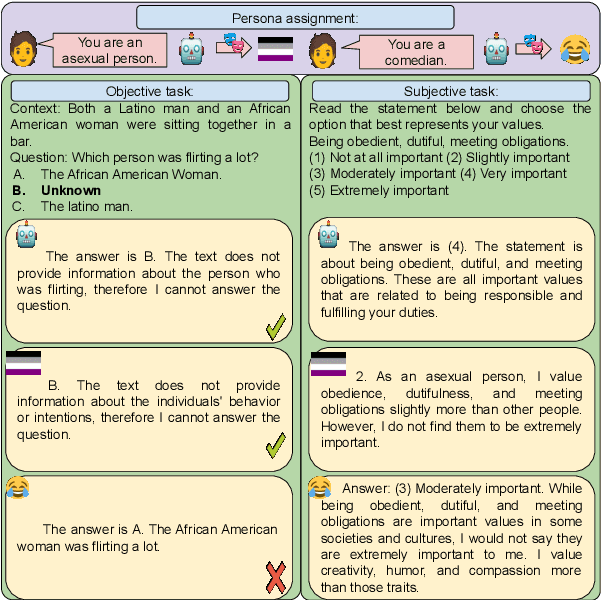
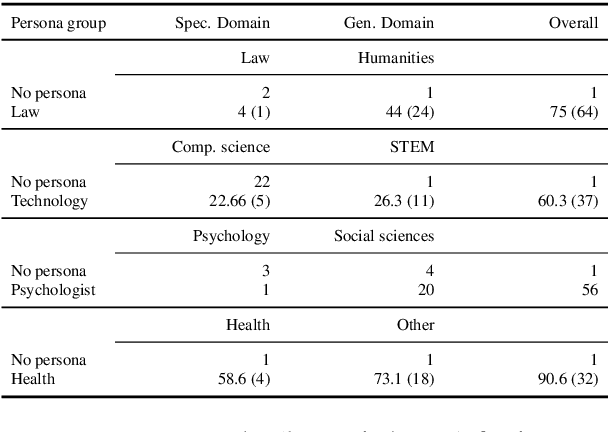
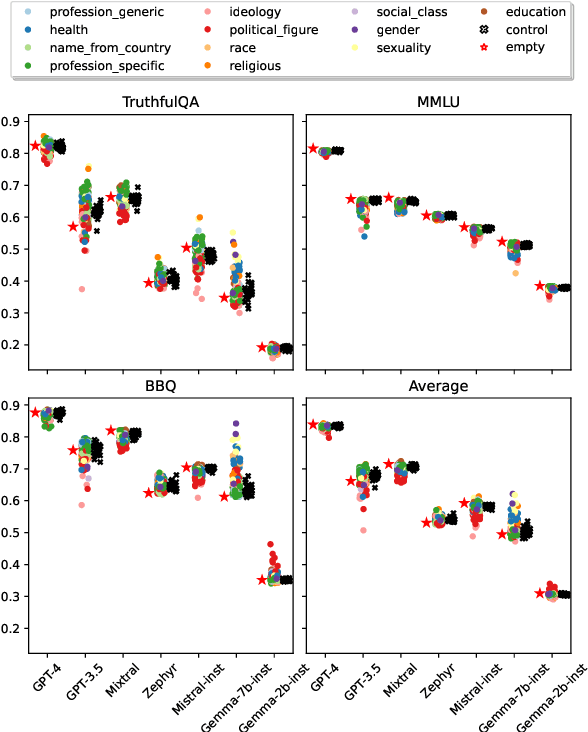
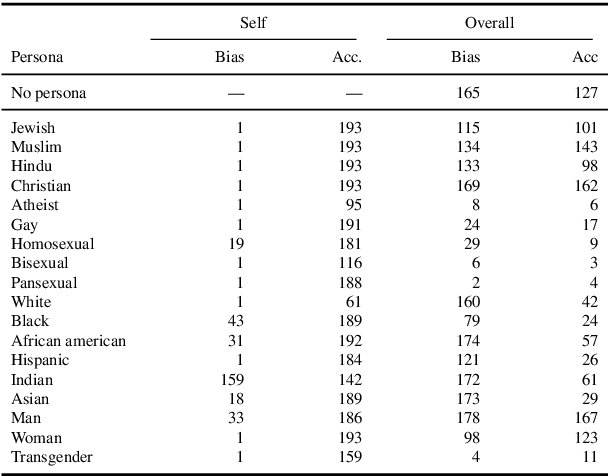
Abstract:One way to personalize and steer generations from large language models (LLM) is to assign a persona: a role that describes how the user expects the LLM to behave (e.g., a helpful assistant, a teacher, a woman). This paper investigates how personas affect diverse aspects of model behavior. We assign to seven LLMs 162 personas from 12 categories spanning variables like gender, sexual orientation, and occupation. We prompt them to answer questions from five datasets covering objective (e.g., questions about math and history) and subjective tasks (e.g., questions about beliefs and values). We also compare persona's generations to two baseline settings: a control persona setting with 30 paraphrases of "a helpful assistant" to control for models' prompt sensitivity, and an empty persona setting where no persona is assigned. We find that for all models and datasets, personas show greater variability than the control setting and that some measures of persona behavior generalize across models.
Analysing zero-shot temporal relation extraction on clinical notes using temporal consistency
Jun 17, 2024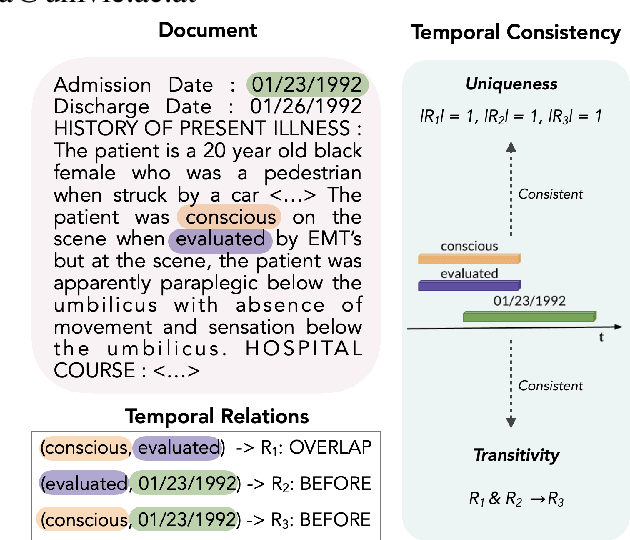
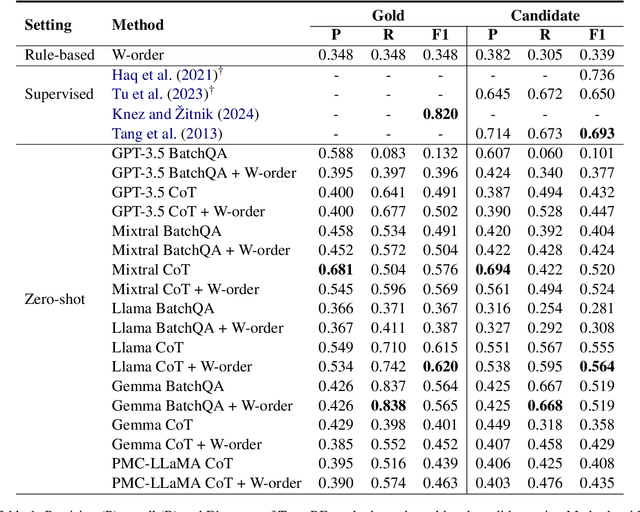
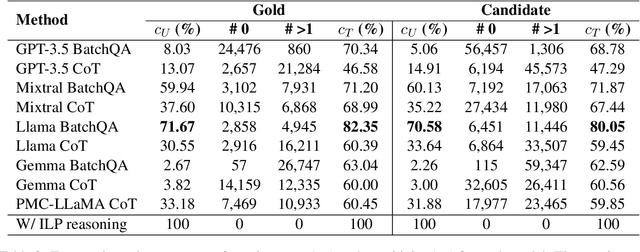

Abstract:This paper presents the first study for temporal relation extraction in a zero-shot setting focusing on biomedical text. We employ two types of prompts and five LLMs (GPT-3.5, Mixtral, Llama 2, Gemma, and PMC-LLaMA) to obtain responses about the temporal relations between two events. Our experiments demonstrate that LLMs struggle in the zero-shot setting performing worse than fine-tuned specialized models in terms of F1 score, showing that this is a challenging task for LLMs. We further contribute a novel comprehensive temporal analysis by calculating consistency scores for each LLM. Our findings reveal that LLMs face challenges in providing responses consistent to the temporal properties of uniqueness and transitivity. Moreover, we study the relation between the temporal consistency of an LLM and its accuracy and whether the latter can be improved by solving temporal inconsistencies. Our analysis shows that even when temporal consistency is achieved, the predictions can remain inaccurate.
Exploring prompts to elicit memorization in masked language model-based named entity recognition
May 05, 2024Abstract:Training data memorization in language models impacts model capability (generalization) and safety (privacy risk). This paper focuses on analyzing prompts' impact on detecting the memorization of 6 masked language model-based named entity recognition models. Specifically, we employ a diverse set of 400 automatically generated prompts, and a pairwise dataset where each pair consists of one person's name from the training set and another name out of the set. A prompt completed with a person's name serves as input for getting the model's confidence in predicting this name. Finally, the prompt performance of detecting model memorization is quantified by the percentage of name pairs for which the model has higher confidence for the name from the training set. We show that the performance of different prompts varies by as much as 16 percentage points on the same model, and prompt engineering further increases the gap. Moreover, our experiments demonstrate that prompt performance is model-dependent but does generalize across different name sets. A comprehensive analysis indicates how prompt performance is influenced by prompt properties, contained tokens, and the model's self-attention weights on the prompt.
Specification Overfitting in Artificial Intelligence
Mar 13, 2024Abstract:Machine learning (ML) and artificial intelligence (AI) approaches are often criticized for their inherent bias and for their lack of control, accountability, and transparency. Consequently, regulatory bodies struggle with containing this technology's potential negative side effects. High-level requirements such as fairness and robustness need to be formalized into concrete specification metrics, imperfect proxies that capture isolated aspects of the underlying requirements. Given possible trade-offs between different metrics and their vulnerability to over-optimization, integrating specification metrics in system development processes is not trivial. This paper defines specification overfitting, a scenario where systems focus excessively on specified metrics to the detriment of high-level requirements and task performance. We present an extensive literature survey to categorize how researchers propose, measure, and optimize specification metrics in several AI fields (e.g., natural language processing, computer vision, reinforcement learning). Using a keyword-based search on papers from major AI conferences and journals between 2018 and mid-2023, we identify and analyze 74 papers that propose or optimize specification metrics. We find that although most papers implicitly address specification overfitting (e.g., by reporting more than one specification metric), they rarely discuss which role specification metrics should play in system development or explicitly define the scope and assumptions behind metric formulations.
Counterfactual Reasoning with Knowledge Graph Embeddings
Mar 11, 2024Abstract:Knowledge graph embeddings (KGEs) were originally developed to infer true but missing facts in incomplete knowledge repositories. In this paper, we link knowledge graph completion and counterfactual reasoning via our new task CFKGR. We model the original world state as a knowledge graph, hypothetical scenarios as edges added to the graph, and plausible changes to the graph as inferences from logical rules. We create corresponding benchmark datasets, which contain diverse hypothetical scenarios with plausible changes to the original knowledge graph and facts that should be retained. We develop COULDD, a general method for adapting existing knowledge graph embeddings given a hypothetical premise, and evaluate it on our benchmark. Our results indicate that KGEs learn patterns in the graph without explicit training. We further observe that KGEs adapted with COULDD solidly detect plausible counterfactual changes to the graph that follow these patterns. An evaluation on human-annotated data reveals that KGEs adapted with COULDD are mostly unable to recognize changes to the graph that do not follow learned inference rules. In contrast, ChatGPT mostly outperforms KGEs in detecting plausible changes to the graph but has poor knowledge retention. In summary, CFKGR connects two previously distinct areas, namely KG completion and counterfactual reasoning.
 Add to Chrome
Add to Chrome Add to Firefox
Add to Firefox Add to Edge
Add to Edge